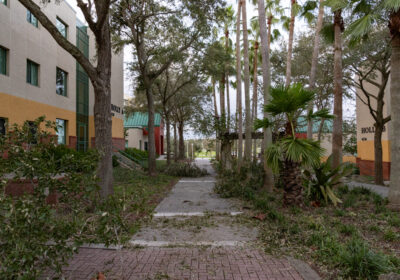USF study questions possibility of life on Europa
With a known universe so large it can defy comprehension, many believe the possibility for life beyond Earth exists. But a new study suggests nearby Europa may not be the most likely home for extraterrestrial life.
Europa, a moon of Jupiter, was identified as having a high potential for life because of its icy crust and 100-mile deep ocean, discovered through data gathered by the Galileo space probe, which orbited Jupiter in the 1990s.
But Matthew Pasek, assistant professor of geology, said his data analysis of Europa’s planetary chemistry, published last month, shows a reduced chance of finding life there.
Using computer modeling software, Pasek and co-researcher Richard Greenberg at the University of Arizona found the chemical composition of Europa’s ocean to be too acidic to support life forms, with a pH level of 2.6. Most water has a neutral pH of 7.
“The very low pH sort of took us by surprise,” he said. “With thinking more about it, it’s probably not as much a surprise as it was. There are places where, in Florida, if you drain the wetlands you would have a buildup of pyrite – iron pyrite, fool’s gold. And then if the wetlands got restored or something like that, (then) water comes down and the water becomes loaded with oxygen, and could possibly cause a big acidification.”
Coca-Cola, vinegar and the water found in the Rio Tinto River in Spain, which has a pH of about 1.5 and a large pyrite mine where water flows through, are liquids found on Earth with similar pH levels to Europa’s icy ocean, Pasek said.
Whereas pyrite causes the high acidity in the Florida wetlands and the Rio Tinto, oxygen is the culprit responsible for the acidity of Europa’s ocean.
Greenberg, a planetary sciences professor who was on the imaging team for the Galileo space probe mission and wrote the book “Unmasking Europa,” said the scientific community now believes that there must be an absence of oxygen for life to begin forming in general.
“Oxygen, although it’s really good for us, it’s a very dangerous substance,” he said. “When oxygen reacts with stuff it tends to destroy biological organisms. So it’s kind of hard for life to get started if there is a lot of oxygen around.”
Greenberg said Europa’s ocean has twice as much water as all of Earth’s oceans combined. He conducted research, published in 2010, to calculate how much oxygen might get into Europa’s ocean.
“A huge amount of this oxygen works its way into the ocean, and that’s really interesting because that suggests – or sort of improves the chances that there would actually be life there because oxygen is very useful in metabolism,” Greenberg said.
Pasek and Greenberg’s study, published in the February 2012 issue of Astrobiology built on Greenberg’s previous work by looking into the chemical composition of Europa with the aid of the modeling software.
“Basically what (Pasek) does is he kind of puts into the model all of the substances that he thinks are available (on Europa, based on the data collected by the Galeleio probe,) and then what the computer does is figure out how those compounds rearrange themselves into a set of compounds given that the initial things can react with one another,” Greenberg said.
They found that oxygen seems to disrupt the chance for life on Europa while it buoys life on Earth because of the varying ways in which each world acquired its oxygen. Earth’s developed through photosynthesis, he said, but Europa’s oxygen content developed through a bombardment of oxides by radiation, which likely led to the formation of oxygen “very soon” after the formation of the solar system.
This quick formation of oxygen probably left a 1 billion- to 2 billion-year window for life as we know it to form, Pasek said. But in Earth’s development, that oxygen-free timeframe did not lead to the formation of any multicellular organisms.
“If you look at Earth in that first 2 billion years, everything was still microbes,” he said. “So yeah, maybe something interesting happened, but still everything was probably microbes. There were no fish, no whales, no coral, nothing large.”
However, the study cannot rule out the possibility of life all together – and Pasek said he only needed to look to the Rio Tinto to show that.
“In there forms these red bacterial gnats, and there is a pH level of 1.5, so even lower than (Europa’s) water, so they’re not so bad at surviving in those environments,” he said. “So that’s sort of the closeat actual biology (found on Earth).”
While their research decreases the chances of finding life on Europa, Pasek said “one neat thing” they found on the moon was an abundance of the mineral vivianite, which could have provided an avenue for developing organisms to thrive despite the acidity of the ocean.
“On Earth, organisms form their vertebrae from apatite,” he said. “It’s what makes up your teeth and your bones. And on Europa there’s a possibility they actually use this mineral called vivianite, which is a blue phosphate, because it is less soluble than apatite. So if you had an exoskeleton made of vivianite, you could actually swim in acid.”
Pasek said he doesn’t think the study completely rules out life on Europa.
“We kind of are at the limits of our speculation right now,” he said. “We had a lot of data, but we’ve pretty much drained it for all it’s worth right now. We would need to go back to Europa to get more data to help constrain us a bit more. Galileo probably sent us as much data back as the average undergrad speaks in a day on a cell phone, so not a lot.”






